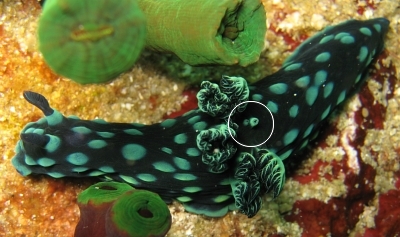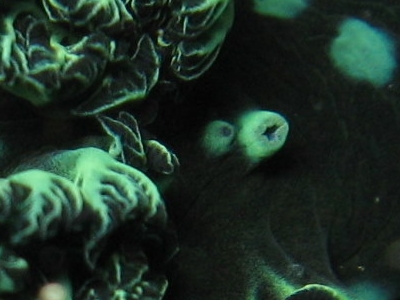Nembrotha cristata - is this the kidney opening?
November 11, 2008
From: Marcel Tanke

Concerning message #7188:
Dear Bill,
Reading your message #7188 I think I also recognise the kidney opening in one of my pictures of Nembrotha cristata. I looked in the anatomy section but found no reference to kidneys.
Locality: Komodo, Indonesia, 3 October 2007. Length: 8 cm. Photographer: Marcel Tanke.
Do nudibranchs, like us, have 2 kidneys? Is the function basically the same? Eg fix (protein) nitrogen into urea, and discard that from the body?
Best regards,
Marcel
marceltanke@cs.com
Tanke, M.A., 2008 (Nov 11) Nembrotha cristata - is this the kidney opening?. [Message in] Sea Slug Forum. Australian Museum, Sydney. Available from http://www.seaslugforum.net/find/21992
Dear Marcel,
Yes the smaller opening on the left of the photo is the kidney opening. In bivalves, cephalopods [squid, octopus] and more primitive gastropods [snails, slugs], the kidneys are paired, but in many gastropods, including the sea slugs the right kidney is either incorporated into the reproductive system or lost, leaving a single kidney. This can form quite a large, sometimes ramifying organ, which is always associated with the heart and pericardial cavity. There is no functional reason for the anus and the renal opening to be so close together. There closeness is another historical relic, reminding us that they sit close together in the mantle cavity of snails, and through all the evolutionary changes that have occurred as snails became slugs, they have remained together.
The kidney in molluscs has two major functions. One is to filter the blood and retain and absorb useful substances, and to remove nitrogenous wastes. In marine molluscs the wastes are normally excreted as urea but there are exceptions. One of these are large squids which store ammonia in the muscle tissue as a flotation device. Eating squid much larger than 40 cm in length can be a terrible experience for this reason.
The other important function of the kidney in molluscs is to retain a normal salt and water balance, This is not a huge problem in marine molluscs, but land molluscs have had to develop secondary structures to retain water, and freshwater ones to retain salts.
Best wishes,
Bill Rudman
Related messages
-
Glossodoris atromarginata - kidney opening on gray sponge
From: Marcel Tanke, January 30, 2009
